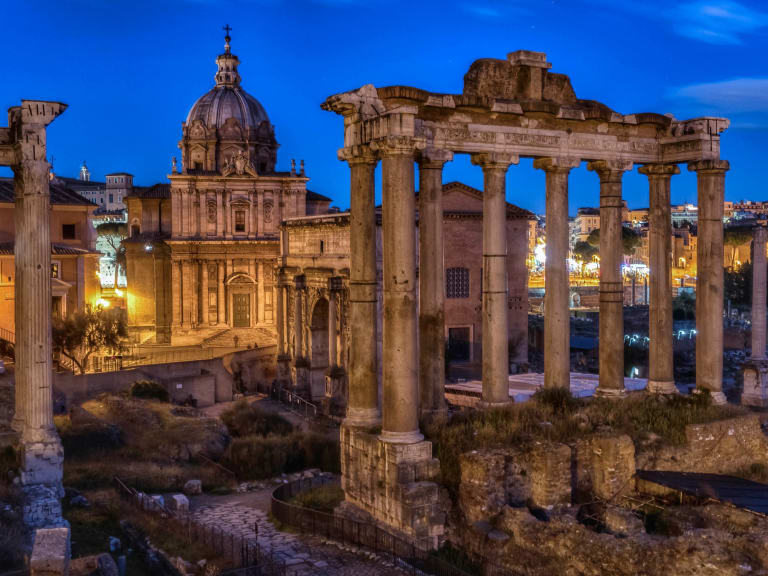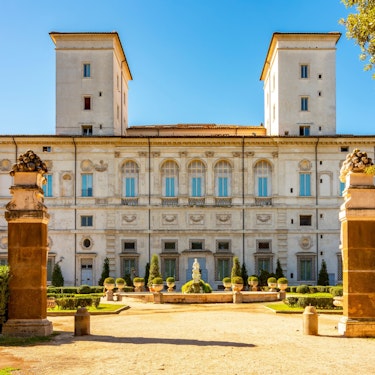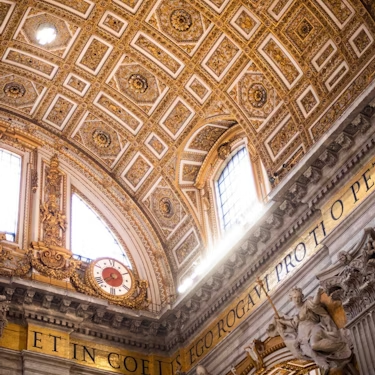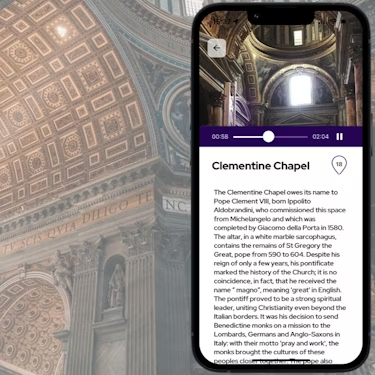More about: 11 Best Museums in Rome
If you are wondering what to see and do in Rome, let me tell you that it is one of the great capitals of the world. A city of undisputed charm, where getting lost in its intricate streets is an adventure in itself. But if what you want is to learn about its past and discover why art found a privileged place here for centuries, then you should visit its countless museums.
With the Sistine Chapel at the top, with the amazing frescoes of Michelangelo or the Pietà, Rome will leave you speechless. The Capitoline Museums, the Borghese Gallery and of course the GNAM, Rome's modern art museum, because it's not all about the past, are also worth a visit. That's why I have selected for you my favorite museums in Rome, put on comfortable shoes because here we go!
1. Visit the Vatican Museum and the Sistine Chapel

Of course, the first of the museums in my top 10 is the Vatican Museum. This is one of the most famous and visited museums in the whole world. Located in Vatican City, it boasts an impressive collection of art and antiquities spanning from ancient Rome to the modern era. Every year, millions of tourists flock to the Vatican Museum to see its exceptional works of art, such as the Sistine Chapel and Raphael's School of Athens.
You won't believe the beauty of this place. The Vatican Museum began as a private art collection of the popes in the 16th century. Over the centuries, the popes continued to add works of art and antiquities to the collection, which was finally opened to the public in 1817. Since then, the museum has continued to grow and expand, and today boasts more than 70,000 works of art and antiquities.
Of course, one of the highlights of the site is the Sistine Chapel. Built in the late 15th century by commission of Pope Sixtus IV. The chapel is famous for its impressive ceiling frescoes, which were painted by Michelangelo, back in 1500. The biblical scenes depicted on the ceiling, including the creation of Adam, are known throughout the world and attract visitors from far and wide. The best option is always to hire a guided tour of the Vatican, although you can also tour it on your own.
How to get to the Vatican
- Metro: Rome's metro line A has a stop at "Ottaviano - San Pietro", which is the closest station to the Vatican. From there, walk for about 10 minutes until you reach St. Peter's Square.
- Bus: lines 64, 62 and 40.
- On foot: the distance from the Trevi Fountain, for example, is about 2.5 kilometers, which is about a 30-minute walk.
2. Visit the Capitoline Museums, in the heart of Rome

At number 2 I have to place one of the oldest museums in the world. I am referring to the Capitoline Museums, a must visit for art and history lovers. Founded in 1471, the museums are located around the famous Piazza del Campidoglio, in the heart of Rome. They are 3 different museums, hence the plural in their name.
A truly impressive collection awaits you here. With a wide range of artworks and historical objects, spanning from ancient Rome to the Renaissance, one of the highlights of the collection is the bronze statue of Marcus Aurelius, which stands in the square in front of the museum, one of the few Roman bronze statues that have been preserved to this day.
On this visit you will also see the Gallery of the Caesars, which houses the statue of the Capitoline She-Wolf, an iconic symbol of the city of Rome and one of the top 10 monuments in the city.
The Capitoline Museums are also known for their beautiful architecture. The museum is housed in a complex of historic buildings, including the Palazzo dei Conservatori and Palazzo Nuovo. The complex was designed by none other than Michelangelo, who also designed the famous spiral staircase leading to the museum. Always remember to check in advance the current opening hours of the Capitoline Museums, as well as the ticket prices.
How to get to the Capitoline Museums
- Metro: the B line of Rome's subway has a stop at "Colosseo", which is the closest station to the Capitoline Museums. From there, you can walk about 10-15 minutes to reach the square.
- Bus: lines 40 and 64.
- Streetcar: streetcar number 8 has a stop in Piazza Venezia, which is a few minutes walk from the Capitoline Museums.
- On foot: the distance from the Trevi Fountain, for example, is about 2 kilometers, which is about a 25-minute walk.
3. Visit the beautiful Borghese Gallery

Another must-see is the Galleria Borghese. It is one of the most outstanding art museums in all of Italy and is located in the beautiful Villa Borghese Park in Rome. The museum has an impressive collection of works of art and sculptures, dating mainly from the Baroque and Renaissance period.
Among the works you can enjoy are sculptures by Bernini, such as the Apollo and Daphne, and the David. In this way and according to your criteria you will be able to discover which are the best sculptures in the Villa Borghese.
You can also marvel at a large number of works by the famous painter Caravaggio and the Roman mosaics of the fourth century. The Borghese Gallery has a beautiful architecture, designed by the architect Flaminio Ponzio in the 17th century. It is divided into two floors and has painted ceilings and decorations that will leave you speechless.
How to get there
- Bus: lines 910, 19 and 52.
- Subway and bus: you can take line A of the Rome subway to the "Flaminio" station, and then take bus number 910 that will drop you off near the entrance of the gallery.
- Streetcar: streetcar number 3 has a stop at Piazzale Flaminio, which is a few minutes walk from the entrance of the Borghese Gallery.
- On foot: the distance from the Trevi Fountain, for example, is approximately 3 kilometers, which is about a 40-minute walk.
4. Tour the Diocleziano Museum in Rome

Housed in an ancient thermal complex, the Diocleziano Museum in Rome is a must-see if you are a lover of history and archaeology. The museum features a wide variety of ancient objects and artifacts, including ceramics, statues, coins and other objects dating back to Roman times.
The thermal complex in which the museum is located was built in the 3rd century AD and was one of the largest of its time. The museum preserves some of the original elements of the complex, including the hot and cold water pools and steam rooms. You can see how the Romans relaxed at that time.
This is definitely one of the places to see in Rome in 3 days, as it is not only a first class museum, but also allows you to see the lifestyle of the city during the Roman Empire.
How to get to Rome
- Metro: lines A and B of the Rome metro stop at Termini station, which is just a few minutes walk from the museum.
- Bus: lines 85, 64 and 910.
- Train: if you are in another part of Italy, you can take a train to Termini station, which is the main train station in Rome.
- On foot: the distance from the Trevi Fountain, for example, is about 3 kilometers, which is about a 40-minute walk.
5. Visit the Galleria Nazionale d'Arte Moderna di Roma (GNAM)

And because not everything is past and history in Rome, I suggest a visit to the National Gallery of Modern Art, a place to enjoy the best of the art of the twentieth and twenty-first centuries. The GNAM is one of the most outstanding museums in Rome and one of the main museums of modern art in Italy. The museum is located in the Villa Borghese park.
Among the highlights you can enjoy here are paintings by French Impressionists such as Monet and Degas, works by renowned Italian artists such as Giorgio de Chirico and Amedeo Modigliani, as well as an impressive collection of modern and contemporary art, including works by Picasso and Jackson Pollock.
The architecture of the building that houses the GNAM is impressive in itself, with a neoclassical facade and spacious exhibition halls with high ceilings and an abundance of natural light. Of all the museums in Rome this one is perfect for visiting with children, as many of the works on display feature a playful, colorful spirit.
How to get to the museum
- Bus: lines 52, 53 and 910.
- Metro and bus: you can take line A of the Rome metro to the "Flaminio" station, and then take bus number 910 which will drop you off near the entrance to the Villa Borghese park, from where you can walk to the museum.
- Streetcar: streetcar number 3 stops at Piazzale Flaminio, which is a few minutes walk from the entrance to the Villa Borghese park.
- On foot: the distance from the Trevi Fountain, for example, is about 3 kilometers, which is about a 40-minute walk.
6. Marvel at the Crypt of the Capuchins Museum

Here I leave you a very peculiar museum, only suitable for those who do not scare easy. It is the Capuchin Crypt Museum, located under the church of Santa Maria de la Concepcion de los Capuchinos. As the name suggests, it is a crypt, which houses the remains of 4,000 Capuchin monks who died since the seventeenth century, along with the remains of some of the city's noble people.
You can walk through corridors crammed with skeletons dressed in their best clothes, some with curious inscriptions. The entrance to the museum will take you through a series of chapels decorated with human bones. Most of the bones are arranged and placed in intricate patterns, like arches and candelabra. One of the most impressive chapels is the Crypt of the Skulls, where you can find thousands of skulls arranged in piles and forming patterns.
There is also a chapel containing the perfectly preserved mummy of a Capuchin monk, Fray Crispin, who died in the 17th century. As you will see, the Capuchin crypt museum is a unique experience. Although it may seem a bit macabre, it is an interesting way to experience the history and culture of the eternal city. And if you're interested in the ecclesiastical, I recommend visiting some of the top 10 churches in Rome.
How to get to Rome
- Metro: The closest metro station to the Capuchin Crypt is the "Barberini" station, which is just a few minutes walk from the site.
- Bus: lines 52, 53 and 63.
- On foot: the distance from the Trevi Fountain, for example, is about 1.5 kilometers, which is about a 20-minute walk.
7. Visit the National Museum of Castel Sant'Angelo

Another must-see museum during your visit to Rome is the Castel Sant'Angelo, an impressive castle located on the right bank of the Tiber River. This castle was originally built as a mausoleum for Emperor Hadrian in 139 AD and was later used as a fortress and papal residence. Its structure is impressive, with thick stone walls and a cylindrical tower, from which you can enjoy one of the best panoramic views of the city of Rome.
Inside the castle, you'll have a chance to explore a variety of rooms, including the weapons room, the chapel, the treasure room and the room of the instruments of torture (which can be a bit unsettling). There are also a series of subway corridors leading to the Vatican, which were used in the past as a secret escape route for popes. Another attraction is the collection of armor, ancient weapons, paintings and sculptures.
How to get to the Vatican
- Metro: the closest metro station to Castel Sant'Angelo is the "Lepanto" station on line A of the Rome metro. From there, you can walk about 10-15 minutes to the castle.
- Bus: lines 23, 34, 49 and 87.
- Streetcar: streetcar number 19 has a stop near Castel Sant'Angelo.
- On foot: the distance from the Trevi Fountain, for example, is about 2 kilometers, which is about a 30-minute walk.
8. Enjoy a tour of the Museum of Contemporary Art (MACRO)

Located in the Testaccio district, in a former brewery, the MACRO is a contemporary art museum that features an extensive collection of artworks by Italian and international artists, with a variety of regularly changing exhibitions. The museum is divided into two sections, the MACRO Testaccio and the MACRO Via Nizza, both housed in renovated historic buildings with modern architecture.
In the MACRO Testaccio you will find a more intimate and cozy space, featuring temporary exhibitions of emerging and established artists. In contrast, the MACRO Via Nizza features a permanent collection of contemporary art, as well as temporary exhibitions of national and international artists. Like the GNAM, here you can appreciate a more modern face of art in Rome.
As most tourists come to the eternal city in search of the past, you will find more locals in these museums. Undoubtedly, one of the must-see museums in Rome for lovers of modern art. The museum closes its doors at 7 pm, so when you leave, you can enjoy one of the best pizzas in Rome, an Italian must.
How to get to the museum
- Metro: the closest metro station to the MACRO is the "Piramide" station on the B line of the Rome Metro. From there, you can walk about 10-15 minutes to the museum.
- Bus: lines 75 and 280.
- Streetcar: streetcar number 3 has a stop near the MACRO.
- Train: the "Roma Ostiense" train station is about 15 minutes walk from the MACRO.
9. Discover Palazzo Massimo alle Terme

Visit the imposing Palazzo Massimo alle Terme. The building that houses the museum itself is a masterpiece of Renaissance architecture and boasts a large collection of ancient art, including sculptures, frescoes, coins and other artifacts.
The museum is divided into four floors, each with its own themed collection. On the first floor, you will see a wide variety of Roman and Greek sculptures, including the famous statue of The Fighter at Rest (or simply The Boxer).
On the second floor, you will see the collection of Roman frescoes and paintings, including works by great Italian masters such as Caravaggio and Tintoretto. On the second floor, a large collection of Roman, Greek and Etruscan coins is on display. Finally, on the upper level, you will see a large number of ancient jewelry, including rings, brooches and earrings. A perfect museum to learn more about the city's past.
How to get to the museum
- Metro: the closest metro station to Piazza Massimo alle Terme is the "Termini" station on the A and B lines of the Rome metro. From there, you can walk about 10 minutes to the square.
- Bus: lines 16, 38, 75 and 360.
- Streetcar: streetcar number 5 has a stop near Piazza Massimo alle Terme.
- Train: the "Roma Termini" train station is just a few minutes walk from the square.
10. Visit the Imperial Roman Forum and its Museum

And number 10 is the Museo dei Fori Imperiali. It is an archaeological museum located in the heart of Rome, in the complex of the Imperial Forums. It was inaugurated in 2007 and has a large collection of artifacts and objects that showcase the history and archaeology of the ancient forums.
Here you can tour several exhibition halls covering different periods of Roman history. The permanent exhibition includes miniature models of the Imperial Forums, as well as frescoes and ancient mosaics. There is also a wealth of ancient artifacts, such as coins, sculptures, and objects of daily life, so visiting seems essential to me.
The museum also offers temporary exhibits that explore different aspects of the history and archaeology of the forums. These exhibits have included topics such as the role of women in Roman society and the ancient construction techniques used.
How to get to the museum
- Metro: the closest metro station to the Piazza dei Fiori Imperiali is the "Colosseo" station on the B line of the Rome Metro. From there, you can walk about 10-15 minutes to the square.
- Bus: lines 51, 75 and 85.
- Train: the "Roma Termini" train station is about 30 minutes walk from the Roman Forum.
























